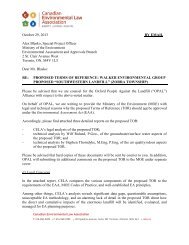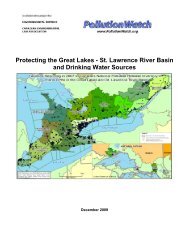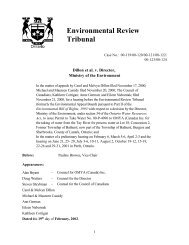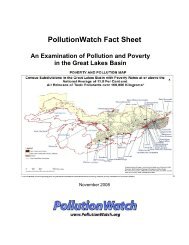H2Ontario - Version 2.0 - POLIS Water Sustainability Project
H2Ontario - Version 2.0 - POLIS Water Sustainability Project
H2Ontario - Version 2.0 - POLIS Water Sustainability Project
- No tags were found...
You also want an ePaper? Increase the reach of your titles
YUMPU automatically turns print PDFs into web optimized ePapers that Google loves.
Reducing Energy ConsumptionEvery time we flush the toilet or turn on the tap, energy is washed down the drain. The cost ofpumping, distribution, and treatment of water and wastewater is a significant expense for most Ontariomunicipalities. 15 Saving water saves energy by reducing pumping, treatment, and heatingrequirements, reducing carbon dioxide emissions and ultimately saving money.∞ CO2 Savings - Toronto <strong>Water</strong>, the municipal operation responsible for water distribution inToronto, uses more electricity than the Toronto Transit Commission and five times the energyconsumed by all of the city’s streetlights and traffic signals. 16 As part of Toronto’s 2007 ClimateChange, Clean Air and Sustainable Energy Action Plan, the city explicitly acknowledges the need toincrease water efficiency as a means of reducing the approximately 550 million kWh used everyyear to treat water and help attain its stated reduction in greenhouse gases by 2011. 17∞ Cost Savings - Energy costs for water pumping and treatment cost the Region of Peel anestimated $25 million dollars in 2006. A study of Ontario municipalities by the Power ApplicationGroup Inc. noted that there has to date been a narrow focus on rapid payback energy efficiencyprograms such as compact fluorescent light-bulb (CFL) replacements. 18 The next generation ofenergy efficiency improvements will need to look beyond light-bulbs. <strong>Water</strong> efficiency andconservation is likely to become among the most cost effective energy reduction strategies formunicipalities. In California, for example, the Energy Commission found that implementation of allidentified water conservation measures could “achieve 95 percent of the savings expected from the2006-2008 energy efficiency programs, at 58 percent of the cost”. 19Protecting the Environment∞ Adaptation - Climate change will impact the hydrologic cycle, making our ecosystems,communities, businesses, and farmers vulnerable. Implementing water efficiency measures nowcan help make ecosystems and communities more resilient to long-term risks and reduce thevulnerability of all sectors to the impacts of a changing climate. 20∞ Mitigation - As described above, water efficiency and conservation presents a significantopportunity for reducing energy use, helping municipalities and the Province mitigate greenhousegas emissions and contribute to the global effort to slow the progression of climate change.∞ Ecosystem Health - Keeping sufficient water in watersheds, wetlands, and aquifers is critical toensuring ecosystem function and health. Functioning watersheds provide valuable ecosystemservices such as purification, flood protection, and habitat. Every litre of water saved representsadditional water available to maintain these critical ecosystems and the services they provide.<strong>H2Ontario</strong>: A Blueprint for a Comprehensive - 8 -<strong>Water</strong> Conservation & Efficiency Strategy
















